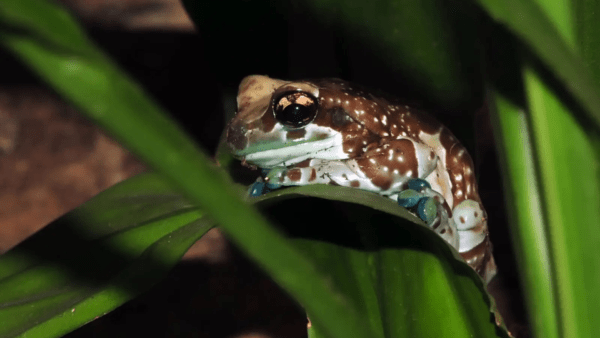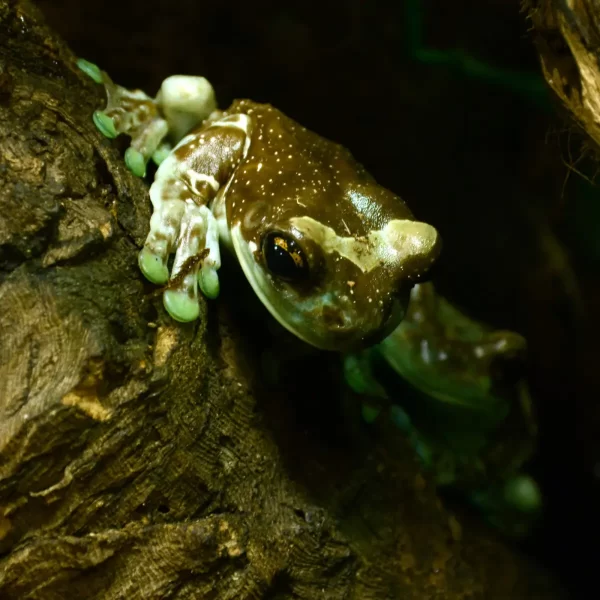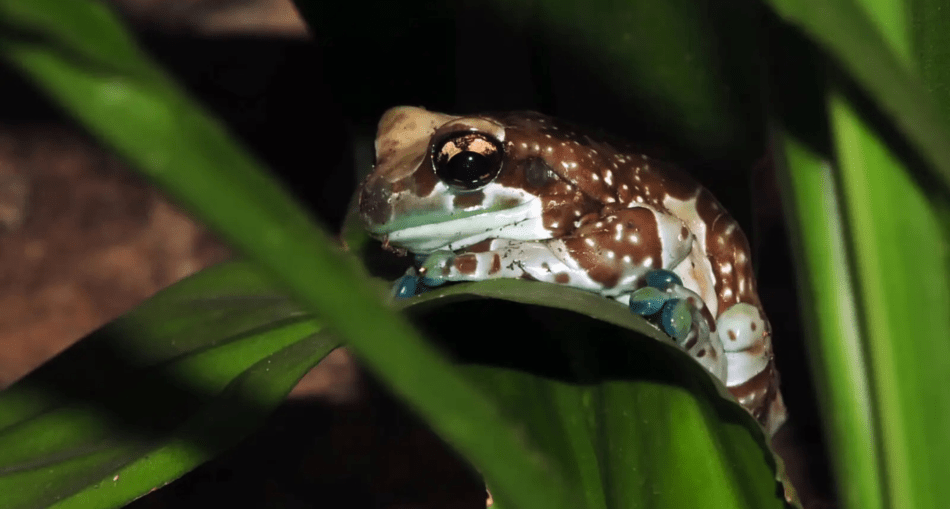The Amazon Rainforest, known for its extraordinary biodiversity, is home to many fascinating species, including the Mission golden-eyed tree frog, also known as the Amazon milk frog (Trachycephalus resinifictrix).

The Golden-Eyed Tree Frog [Photo: Michael Gäbler]
This striking and somewhat elusive amphibian is native to the tropical rainforests of South America, including the lush habitats of Guyana.
ANATOMY AND APPEARANCE: A MARVEL OF NATURE
The Mission golden-eyed tree frog is relatively large for a tree frog, reaching lengths between 2.5 and 4 inches (6.4 to 10.2 cm) in adulthood.
Its body is light grey and adorned with brown or black banding.
As juveniles, these frogs display more vivid contrasts, with the colour patterns becoming more muted as they mature. Their skin texture becomes slightly bumpy as they age, adding to their distinct appearance.
One of the most striking features of this species is its blood, which takes on a subtle blue tint that can be seen through its translucent skin, particularly around the mouth and on its toe pads.
This unusual colouration, coupled with their vibrant greenish-yellow eyes, gives the frog a mystical, almost otherworldly appearance.
THE “MILK” IN THE NAME: A UNIQUE DEFENSE MECHANISM
The Mission golden-eyed tree frog is often referred to as the Amazon milk frog or blue milk frog, a nod to its unique feature: the milky secretion it produces when feeling threatened.
This sticky, milky substance is a defence mechanism used to deter predators. It’s a fascinating survival trait that sets these frogs apart from others in the rainforest.
HABITAT: THRIVING IN GUYANA’S TROPICAL RAINFORESTS
The Mission golden-eyed tree frog is a true rainforest dweller. It is commonly found in the dense tropical forests.
These frogs tend to inhabit vegetation that stretches over permanent, slow-moving water sources like streams and rivers. The humidity and temperature of these habitats are essential for the frog’s survival.
DIET: CARNIVOROUS AND OPPORTUNISTIC FEEDERS
As carnivores, the Mission golden-eyed tree frog preys on a variety of insects in its native environment.
In captivity, these frogs are typically fed a diet of crickets, worms, and other insects. Their feeding habits are essential to their role in the ecosystem, where they help control insect populations.

The Golden-Eyed Tree Frog [Photo: Vassil]
Their large mouths and voracious appetites allow them to consume a wide range of prey, making them effective hunters in their arboreal homes.
Despite their size, they rely on stealth and quick movements to capture insects, making them highly skilled predators.
IN CAPTIVITY: THE AMAZON MILK FROG AS A PET
In addition to thriving in the wild, the Mission golden-eyed tree frog is becoming increasingly popular in captivity, particularly among exotic pet enthusiasts.
These frogs are relatively easy to care for as long as their environmental needs are met. They require ample space, high humidity, and regular enclosure maintenance to ensure a healthy habitat.
Their preferred temperature range in captivity mirrors their natural habitat, typically between 21°C and 30°C (70°F to 86°F). Owners of these frogs must maintain humidity levels and provide a clean, safe environment for the frogs to thrive. In return, the Amazon milk frog offers its caretakers a stunning display of colors and behaviors, as well as the satisfaction of caring for such a unique creature.
REFERENCES
- https://en.wikipedia.org/wiki/Mission_golden-eyed_tree_frog
- https://animalia.bio/mission-golden-eyed-tree-frog







